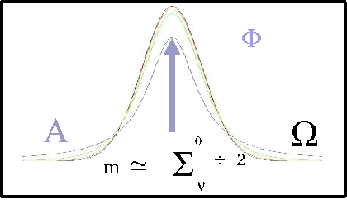
 |
|
|
Goff's Law Revisited  29 July 2001, 21:14 PDT
The Rule of Halves is very simple. For any population, by any measure,
half will on one side of the median, half the other. It's a simple restatement
of the definition of 'median' in statistics. But not unlike observations
like the Golden Mean, or the Fibonacci Numbers, the Rule of Halves enjoys
natural manifestations at all levels of organization.
Cardiologists speak of a rule of halves to explain why high blood pressure
remains such a scourge. Half the sufferers, they say, go undetected. Half of
those detected remain go untreated. And half of those that are treated remain
uncontrolled. The same rule seems to apply to heart failure diagnosis and
treatment. In terms of specifics dysfunctions, half of the patients are
clinicaly asymptomatic or very midly symptomatic; a quarter has true heart
failure, and another quarter has heart failure and is appropriately treated.
In fact, arguably many maladies, such as cancer, heart disease, high blood
pressure, strokes, diabetes and obesity, follow the rule of halves:
For every patient identified to have the disease there is another in the
community about to develop it.
The Rule of Halves applies to the successful staffing of volunteer projects.
If you need 50 volunteers to pitch in for a day for a cause, any
worthwhile cause, be sure to receive 100, "I'll definitely be there,"
phone confirmations the evening prior to the event.
In art, the rule of halves is prevalent. For example, when drawing
a human face, one can divide the face (beginning with an oval) with three
lines; the first line divides the oval into two halves, the top and bottom.
The second line divides the bottom quadrant into two more equal sections, and
the third line divides the new bottom quadrant yet again. So we have the face
divided into 1/2, 1/4 and 1/8...
From a mental health perspective, physicians estimate that half of all general
practice patients may have some depressive symptoms. When confronted
with such a diagnosis, half choose not to pursue a clinical remedy.
While only 50% of people suffering from depression will actually seek
medical treatment, only 50% of those who seek such treatment will be
correctly diagnosed. Of that half only 50% will receive medication at a
therapeutic level and of that 50% only half will actually complete the
recommended course. The effect of the rule of halves (applied
recursively) is that of every one hundred people suffering from depression
only seven will effectively be treated.
Accountants have a rule of halves for estimating annuity needs,
tax consequences and estate planning. Venture capitalists have a rule
of halves for innovative but risky investments. Athletes have a rule
of halves for recovering from an injury.
Two points bear reflection:
|